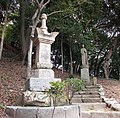Hōkyōintō
The examples and perspective in this article deal primarily with Japan and do not represent a worldwide view of the subject. (February 2019) |
You can help expand this article with text translated from the corresponding article in Chinese. (February 2019) Click [show] for important translation instructions.
|

A hōkyōintō (宝篋印塔) is a Japanese pagoda, so called because it originally contained the Hōkyōin (宝篋印) dharani (陀羅尼) sūtra.[1] A Chinese variant of the Indian stūpa, it was originally conceived as a cenotaph of the King of Wuyue – Qian Liu.[1]
Structure and function
Usually made in stone and occasionally metal or wood, hōkyōintō started to be made in their present form during the Kamakura period.[1] Like a gorintō, they are divided in five main sections called (from the bottom up) kaeribanaza (反花座), or "inverted flower seat", kiso (基礎), or base, tōshin (塔身), or body, kasa (笠), or umbrella, and sōrin (相輪), or pagoda finial.[1] The tōshin is the most important part of the hōkyōintō and is carved with a Sanskrit letter.[2] The 'sōrin has the same shape as the tip of a five-storied pagoda.[2] The kasa can also be called yane (屋根), or roof.[2] It's decorated with four characteristic wings called mimikazari (耳飾)[1] or sumikazari (隅飾).[2] Different structures exist, and the hōkyōintō property of the Yatsushiro Municipal Museum in Kyushu for example is divided in just four parts, with no kaeribanaza.[2]
The sūtra contain all the pious deeds of a Tathagata Buddha, and the faithful believe that praying in front of a hōkyōintō their sins will be canceled, during their lives they will be protected from disasters and after death they will go to heaven.[2]
The hōkyōintō tradition in Japan is old and is believed to have begun during the Asuka period (550–710 CE).[2] They used to be made of wood and started to be made in stone only during the Kamakura period.[2] It is also during this period that they started to be used also as tombstones and cenotaphs.[2]
Gallery
-
in Mount Putuo
-
in Quanzhou
-
in Beijing
-
Hōkyōintō at Ishiyama-dera (Otsu)
-
Hōkyōintō at Onsen-ji (Toyooka)
-
Hōjō Masako's Hōkyōintō (Kamakura)
-
Hōkyōintō at Mizuma-dera near Osaka
Notes
References
- Iwanami Kōjien (広辞苑) Japanese dictionary Sixth Edition, DVD Version (in Japanese)
- Shinkō no Katachi - Hōkyōintō, Yatsushiro Municipal Museum, accessed on September 18, 2008 (in Japanese)
- "Nihon Rekishi Chimei Taikei (日本歴史地名大係), online version". Hatakeyama Shigeyasu no Haka (in Japanese). Heibonsha. Archived from the original on 2008-11-07. Retrieved 2008-09-18.










